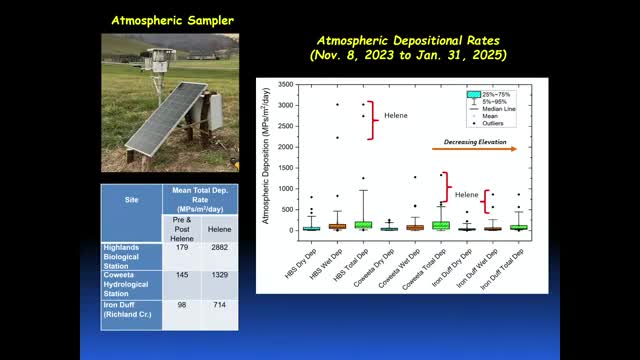Researchers document microplastic surge in Pigeon River post-Hurricane Helene
March 12, 2025 | Town of Waynesville, Haywood County, North Carolina
Thanks to Scribe from Workplace AI , all articles about North Carolina are free for you to enjoy throughout 2025!

This article was created by AI using a video recording of the meeting. It summarizes the key points discussed, but for full details and context, please refer to the video of the full meeting. Link to Full Meeting
The data showed that areas with higher elevations, such as Highlands, experienced the highest rates of microplastic deposition, averaging between 80 to 100 particles per square meter per day. However, during Hurricane Helene, this number surged dramatically, with nearly 3,000 particles deposited daily at the Highlands Biological Station. The predominant materials identified were nylon, polyester, and other textile-related plastics, indicating that these pollutants may originate from distant sources.
In addition to atmospheric deposition, the study revealed a staggering increase in microplastic concentrations in local rivers. For instance, the Waynesville skate park area saw a rise from approximately 1.2 billion particles per day to an astonishing 61 billion particles per day during the storm. The Pigeon River at Canton recorded even higher estimates, reaching nearly 1.9 trillion particles daily.
The implications of these findings extend beyond immediate water quality concerns. Microplastics are accumulating in sediments, where they can be ingested by aquatic organisms, such as caddisflies, which are known to incorporate these particles into their nests. This raises concerns about the potential for microplastics to enter the food chain, affecting local fish populations and, ultimately, human health.
While the water clarity in the watershed remains relatively good, the presence of microplastics poses a significant challenge for environmental management. The council discussed ongoing efforts to characterize these pollutants in flood deposits and their potential impact on the ecosystem.
As the community grapples with these findings, the need for continued monitoring and action to address plastic pollution in the waterways has never been more critical. The council's commitment to understanding and mitigating these environmental challenges will be essential for safeguarding the health of the local ecosystem and its residents.
Converted from Town Council Meeting: March 11, 2025 meeting on March 12, 2025
Link to Full Meeting
Comments
View full meeting
This article is based on a recent meeting—watch the full video and explore the complete transcript for deeper insights into the discussion.
View full meeting